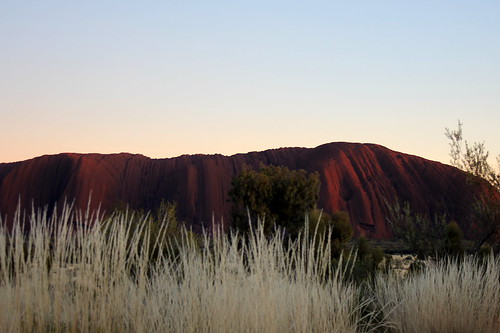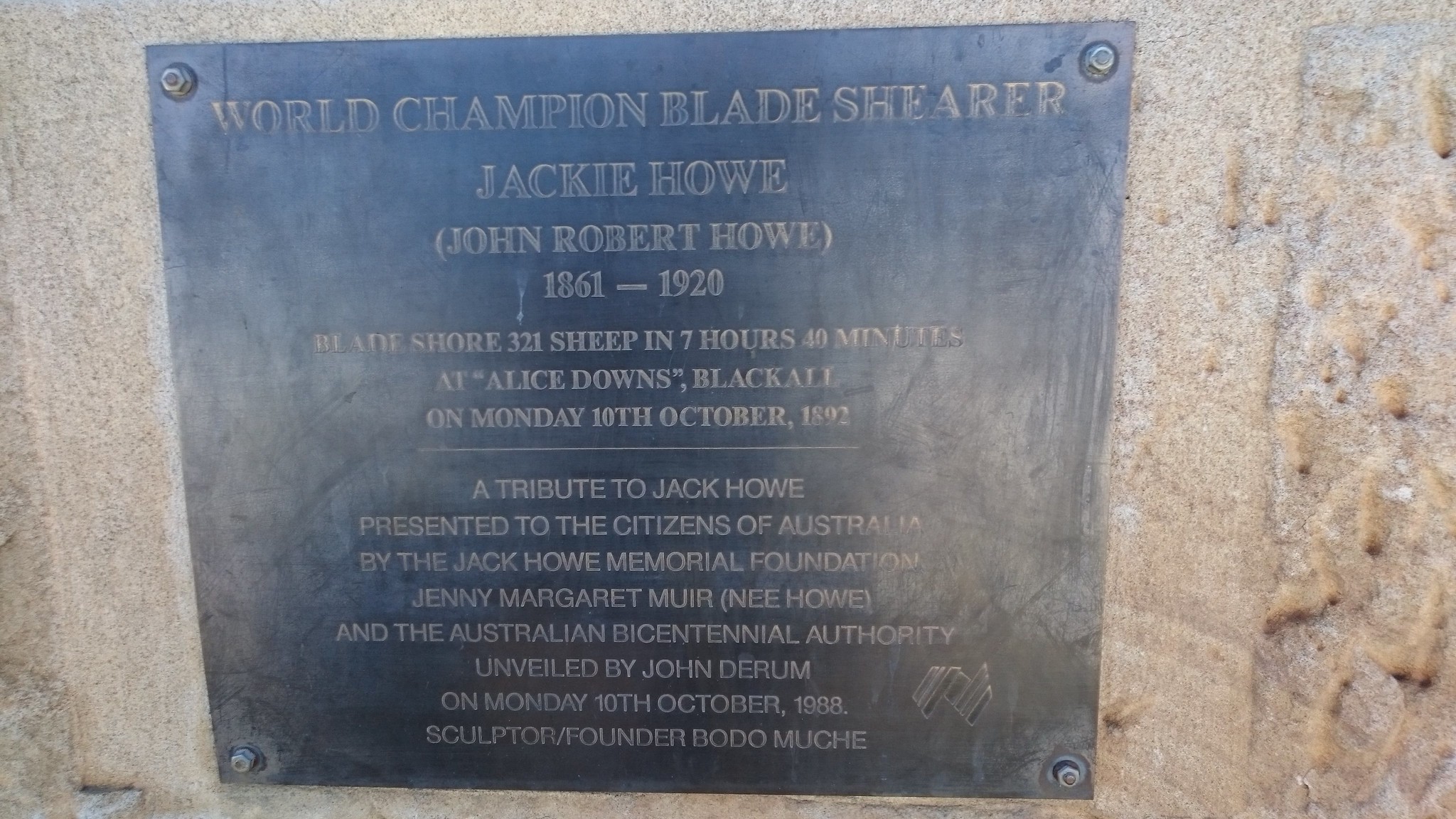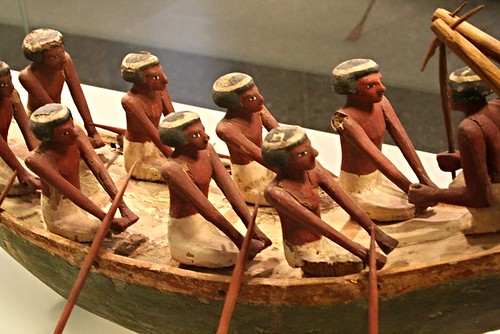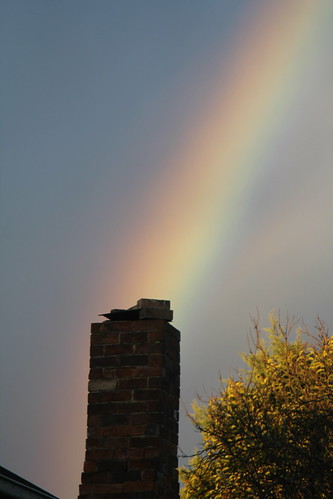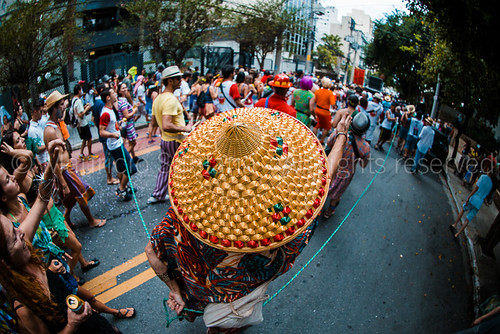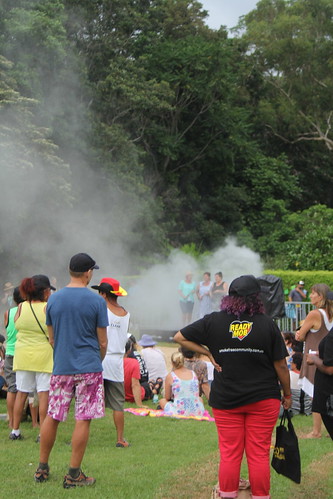My love of this place is ongoing. It grows still day by day and the lessons I learned there will stay with me for an eternity. I finally journeyed there in 2012 with my friend Suzy and her Uncle who was the Gumbayngirri elder, Uncle Tom. Uncle Thomas Kelly was 88 when we went and he has now passed.
The exact time to go here was set down at the creation and we just answered the call. I recall sitting with Aunty Alison Hunt and listening to her explain Tjukurpa to me for the first time and how Tjukurpa was everything, in everything and it was everything. I remember the instant correlations to Ancient Hermetic / Natural Law. It is immutable and governs all and is not man made etc and I understood totally what she meant.
Not a day goes past that I don't allow my mind to wander back along those red paths we walked on ancient ground where we heard the voices of the old people welcoming us and letting us know they knew we were there and why.
The following article is informative from a base knowledge on what Tjukurpa is and if you are intending to go to Uluru you should on all accounts familiarize yourself with this out of due respect for the Anangu people and what they have known intimately for thousands and thousands of years.
(There is not a single word in English that conveys the complex meaning of Tjukurpa. This is why at Uluru - Kata Tjuta National Park we use the Pitjantjatjara word. The Traditional Owners who speak Yankunytjatjara use the word Wapar to mean the same complex body of Law and beliefs).The exact time to go here was set down at the creation and we just answered the call. I recall sitting with Aunty Alison Hunt and listening to her explain Tjukurpa to me for the first time and how Tjukurpa was everything, in everything and it was everything. I remember the instant correlations to Ancient Hermetic / Natural Law. It is immutable and governs all and is not man made etc and I understood totally what she meant.
Not a day goes past that I don't allow my mind to wander back along those red paths we walked on ancient ground where we heard the voices of the old people welcoming us and letting us know they knew we were there and why.
The following article is informative from a base knowledge on what Tjukurpa is and if you are intending to go to Uluru you should on all accounts familiarize yourself with this out of due respect for the Anangu people and what they have known intimately for thousands and thousands of years.
Tjukurpa is the foundation of Anangu life.
What is Tjukurpa/Wapar?
The term, Tjukurpa/Wapar, includes many complex but complementary concepts.Tjukurpa/Wapar encompasses:
- Anangu religion, law and moral systems;
- the past, the present and the future.
- the creation period when ancestral beings, Tjukaritja/Waparitja, created the world as it is now;
- the relationship between people, plants, animals and the physical features of the land; and
- the knowledge of how these relationships came to be, what they mean and how they must be maintained in daily life and in ceremony.
Tjukurpa/Wapar Versus Dreamtime/Dreaming
'Dreamtime' or 'Dreaming' is often used to describe the way Anangu see their origins. This translation, originally made by non-Aboriginal people, suggests the beliefs are unreal and changeable. Tjukurpa/Wapar is no dream, and there is no such word as 'Dreamtime' in Anangu language.Anangu are pleased that this interaction between themselves and the land has now been recognized as being of World Heritage value.
The Creation Period
The world was once a featureless place. None of the places we know existed until creator beings, in the forms of people, plants and animals, traveled widely across the land. Then, in a process of creation and destruction, they formed the landscape as we know it today. Anangu land is still inhabited by the spirits of dozens of these ancestral creator beings which are referred to as Tjukuritja or Waparitja.
Mala, or rufous hare-wallaby
The journeys and activities of the creator beings are recorded in the landscape. Sites where significant events in their story took place are linked by what we call, iwara (paths or tracks). Some of the sites are so very significant that they are known as 'sacred sites'. Today our people still know where these sites and these iwara are and where they go although there is no physical road. Our grandmothers and grandfathers teach us this.
The iwara (tracks) link places that are sometimes hundreds of kilometres outside the Park and beyond Yankunytjatjara/ Pitjantjatjara country. So they are significant to other groups of indigenous people too.
For example, the Mala Tjukurpa involves three groups of Mala (rufous hare-wallaby) people who travel from the north to reach Uluru. Two groups then flee south and south-east to sites in South Australia. Kuniya Tjukurpa tells of the travels of the Kuniya (Woma Python) from hundreds of kilometres east of Uluru.
Many other Tjukurpa such as Kalaya (Emu), Liru (poisonous snake), Lungkata (blue tongue lizard), Luunpa (kingfisher) and Tjintir-tjintirpa (willie wagtail) travel through the Park. Other Tjukurpa affect only one specific area. Many exploits of Tjukurpa involve ancestral beings going underground.
Kuniya, the woma python, lived in the rocks at Uluru where she fought the Liru, the poisonous snake
Anangu landscapes are therefore full of meaning. They represent creation stories and associated knowledge of Law, relationships, plants, and animals represented in the shapes and features of the land. This knowledge has been passed down between the generations from grandparents to grandchildren. With the knowledge comes responsibilities and obligations to care for the land and each other in the proper way.
When Anangu travel across the land they do so with the knowledge of the exploits of the ancestral beings. Their knowledge of the land, and the behaviour and distribution of plants and animals is based on their knowledge of Tjukurpa. The elder people recount, maintain and pass on this knowledge through stories, behaviour, rituals, ceremonies, songs, dances and art.
Tjukurpa is the basis of all Anangu knowledge. The deeper meanings of Tjukurpa, known to the old and most senior people, are the keys that underpin everything in Anangu life - knowledge, attitudes, relationships, economics, spirituality, physical and emotional wellbeing. Tjukurpa connects everything in life. Therefore changes to any part of the land or the relationships have ramifications for other things.
Anangu Moral Belief SystemTjukurpa provides Anangu with a whole way of life. It includes rules, obligations, responsibilities and guidelines for relationships. Tjukurpa is the key that underpins Anangu attitudes and guides people's spiritual, physical, mental, emotional, moral and economic behaviour. It guides daily life through a series of symbolic stories and metaphors. The stories are not simple stories, but represent technically complex explanations of the origins and structure of the universe, and the place and behaviour of all elements within it. Ancestors provide the example of how to behave.Understanding of such stories increases throughout their lives. For a child, a story may be a moral tale about greed, while for an adult it may provide complex explanations of ethical behaviour. |
Law
Tjukurpa establishes the rules Anangu use to govern society and manage their land. It dictates correct procedures for dealing with problems, and penalties for breaking the Law. The proper way of doing things is the way things are done in Tjukurpa.Since the coming of non-Aboriginal people Anangu have had to modify some of the penalties under traditional Law. Anangu have also adapted non-Aboriginal law to help enforce Tjukurpa. Sacred sites are protected under Commonwealth and Northern Territory legislation and hunting and foraging rights are protected under the legislation and lease agreement with the Director of National Parks.
The Uluru-Kata Tjuta National Park Plan of Management protects Tjukurpa by using it as a guide for making management and policy decisions.
Children preparing to learn the Kuniya inma
Passing on Tjukurpa
Tjukurpa is not written down, but is an oral culture. It is a cultural obligation to pass on this knowledge to the right people. Ceremonies play an important role in the passing on of knowledge. Specific people or groups in a kinship system have responsibility to maintain different sections of Tjukurpa. This knowledge is carefully passed on to people who have inherited the right to that knowledge through, for example, their birthplace, or earned the right, for example, by progressive attendance at ceremonies.There are many interrelated devices for remembering Tjukurpa, such as specific verses of inma (songs), site-related stories, ritual dances or art. The iwara (ancestral paths) are recalled in long sequential lists of sites, sometimes including sites beyond country which has been visited, and including sites belonging to other people.
Tjukurpa is also recorded in various designs and paintings, such as the 'dot' paintings of the Western Desert. These designs are often sacred, and use and creation is restricted to specific groups or individuals.
Some sounds are associated with particular Tjukurpa. The sound of the bullroarer, for example, is associated with secret men's ceremonies. It is for this reason that Anangu don't want bull roarer-like objects sold to tourists in the local area.
Tjukurpa is extremely important to Anangu. They can share some information with non-Aboriginal people, but the secret, sacred information must be protected and remain only with senior Anangu.
Tjukurpa in Park Management
Tjukurpa is the foundation of the Joint Management arrangement at Uluru - Kata Tjuta National ParkTjukurpa and Park Visitors
While Anangu welcome visitors to the Park, they ask that you respect the importance of the place. For Anangu an essential part of 'keeping the Law straight' involves ensuring that knowledge is not imparted to the wrong people and that access to significant or sacred sites is not gained by the wrong people, whether wrong means men or women, Piranpa (non-Aboriginal) visitors or certain other Anangu. It is as appropriate for Anangu to care for these places as it is for non-Aboriginal religions to care for their churches, sacred precincts and relics. Even inadvertent access to some sites may be sacrilegious.| At Uluru - Kata Tjuta National Park some areas are fenced off and sometimes photography is restricted to ensure visitors do not inadvertently contravene Tjukurpa restrictions. |
Anangu explanations of the Park's landscape form the core of interpretive materials prepared for visitors. These include brochures and signs and the interpretive display at the Cultural Centre.
Reproduced by permission of © Commonwealth of Australia
Anangu Languages
Anangu is the term that Yankunytjatjara and Pitjantjatjara Aboriginal people from the Western Desert region of Australia use to refer to themselves.In the past the word Anangu had a more specific usage, being used to refer to a person or people as opposed to other non-human forms of life. Over the years, since contact with Europeans, it has come into common use in the region as a term referring to Aboriginal people, as opposed to non-Aboriginal people, as well as Aboriginal people who come from other parts of Australia.
Many Mutitjulu Anangu speak Yankunytjatjara and Pitjantjatjara. Ngaanyatjarra and Luritja are also spoken in this region. These are all dialects of what linguists term the Western Desert Language, Aboriginal Australia's largest language group. Western Desert dialects are sometimes grouped together and conveniently, though inaccurately, labelled Pitjantjatjara. Anangu who speak Western Desert dialects can be found from Halls Creek and Balgo in the north of Western Australia through to Oodnadatta and Yalata in South Australia.
Approximate Distribution of Languages and Dialects Associated with Uluru
Pitjantjatjara word definitions
Generally Pitjantjatjara words are used throughout the Park, however significant numbers of people in the Mutitjulu community speak Yankunytjatjara. Here are some words you might encounter:| Yankunytjatjara | Pitjantjatjara | English |
| tjakipiri | kalaya | emu |
| kuniya | kuniya | woma python |
| kurkapi | kurkara | desert oak |
| wami | liru | poisonous snake |
| kalamita, langka | lungkata | blue tongue lizard |
| ruulpa | luunpa | kingfisher |
| mala | mala | rufous hare wallaby |
| malu | malu | red kangaroo |
| ngura | ngura | home |
| piyanpa | piranpa | white person, non-Aboriginal |
| waparitja | tjukuritja | ancestral beings of the creation period |
| wapar | tjukurpa | Law, referring to the creation period |
| kanku | wiltja | house, shelter |
| kurku | wanari | mulga tree |
| mungawayuru | wayuta | brush tail possum |
Reproduced by permission of © Commonwealth of Australia
Images @ Eminpee Fotography
